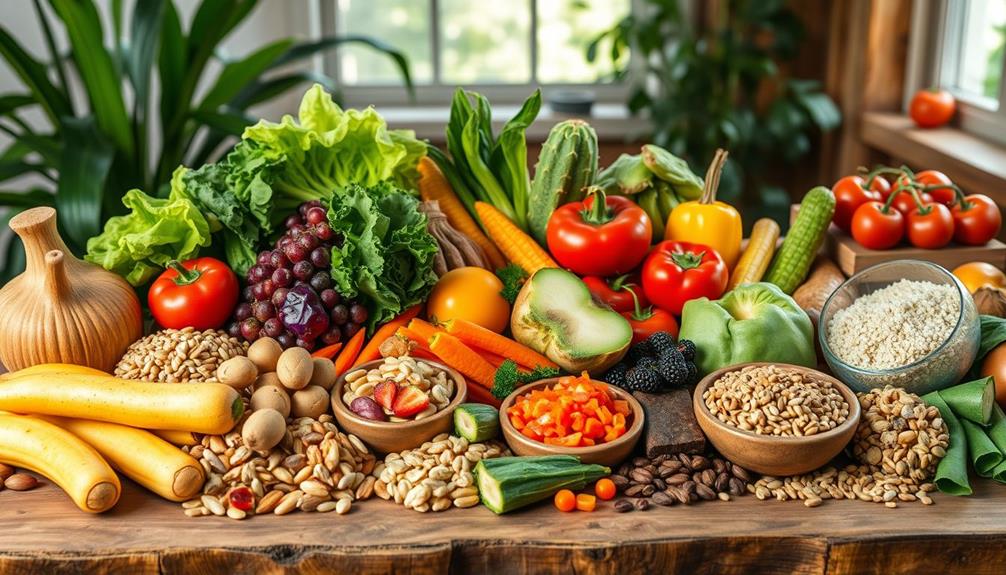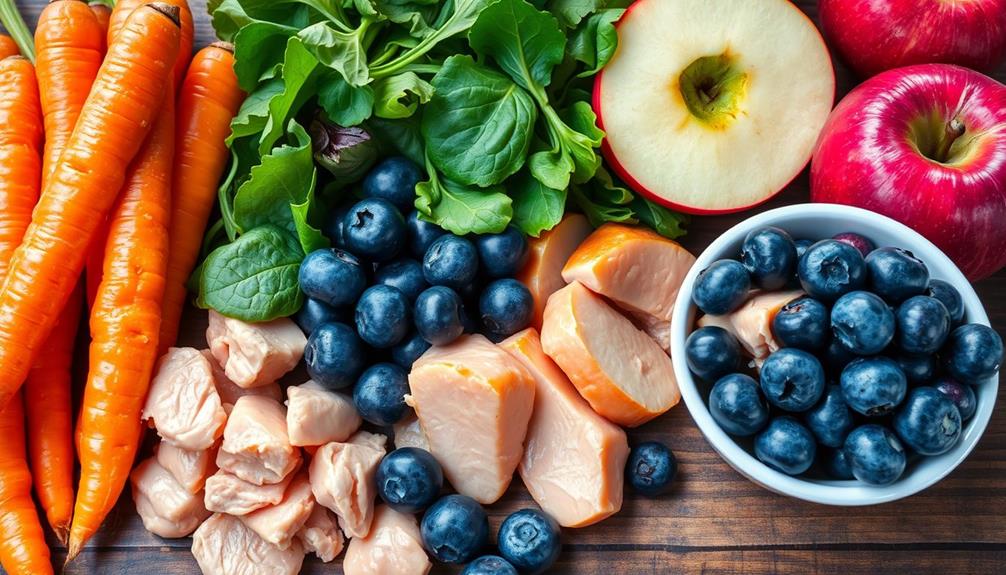Raw food items include uncooked fruits, vegetables, nuts, seeds, and unique superfoods. You'll find essential fruits like apples, bananas, and berries packed with antioxidants. Leafy greens such as spinach and kale boost your nutrient intake, while colorful veggies like bell peppers and carrots add phytonutrients. Don't overlook raw nuts and seeds, including almonds, chia seeds, and flaxseeds, which provide healthy fats and fiber. Cold-pressed oils and fresh herbs enhance your dishes. Unique foods like edible weeds and superfoods like spirulina offer even more benefits. If you're curious about specific items and their uses, there's plenty more to explore!
Key Takeaways
- Raw food items include uncooked fruits, vegetables, nuts, seeds, and sprouted foods for optimal nutrient intake and health benefits.
- Essential fruits like apples, bananas, and berries are rich in antioxidants and vital vitamins.
- Leafy greens such as spinach and kale enhance digestion and nutrient density in a raw diet.
- Cold-pressed oils and raw nut butters provide healthy fats and flavor without processing.
- Unique foods like edible weeds, seaweeds, and superfoods like spirulina enrich the diet with additional nutrients.
Overview of Raw Food Items
Raw food items form the foundation of a vibrant, health-focused diet. When you embrace a raw food lifestyle, you prioritize uncooked fruits, vegetables, nuts, and seeds, which are rich in natural nutrients. These foods maintain their enzymes and nutrients, allowing you to reap the benefits of high nutrient density.
Additionally, incorporating foods like celery juice can enhance your hydration and detoxification efforts. In your raw food journey, you'll discover a variety of delicious uncooked fruits like apples, bananas, and berries. Each of these fruits provides essential vitamins and antioxidants that support overall health.
Incorporating vegetables such as spinach, kale, carrots, and bell peppers adds fiber and essential nutrients to your meals, enhancing your daily intake of plant-based foods. Nuts and seeds, including raw almonds, chia seeds, and sunflower seeds, are vital for providing healthy fats and protein, helping you sustain energy throughout the day.
You might also explore unique raw items like edible weeds—such as dandelion—seaweeds like nori and dulse, and superfoods like spirulina and maca, which can elevate the nutritional value and variety of your diet. By focusing on these raw foods, you're setting a strong foundation for a healthier you.
Essential Fruits and Vegetables

Embracing a variety of essential fruits and vegetables can greatly enhance your raw food diet. These foods not only provide crucial vitamins and minerals but also deliver numerous health benefits. Essential fruits like apples, bananas, berries, and citrus fruits are packed with antioxidants that support overall health. Incorporating leafy greens such as spinach, kale, and romaine lettuce can help boost your nutrient intake and improve digestion thanks to their fiber content.
Colorful vegetables like bell peppers, carrots, and tomatoes add phytonutrients to your meals, enhancing nutrient density. Don't forget about sprouted vegetables like alfalfa and broccoli sprouts, which are nutrient-dense and add a delightful crunch to salads and wraps. To maximize the freshness and flavor of your diet, focus on seasonal produce.
Here's a quick overview of essential fruits and vegetables:
| Type | Examples | Benefits |
|---|---|---|
| Essential Fruits | Apples, Bananas, Berries | Vitamins, Minerals, Antioxidants |
| Leafy Greens | Spinach, Kale, Romaine | High Fiber, Nutrient-Rich |
| Colorful Vegetables | Bell Peppers, Carrots, Tomatoes | Phytonutrients, Nutrient Density |
| Sprouted Vegetables | Alfalfa, Broccoli Sprouts | Enzymes, Nutrient-Dense |
Incorporating these foods into your raw meals is a simple way to elevate your nutrition.
Nuts, Seeds, and Sprouts
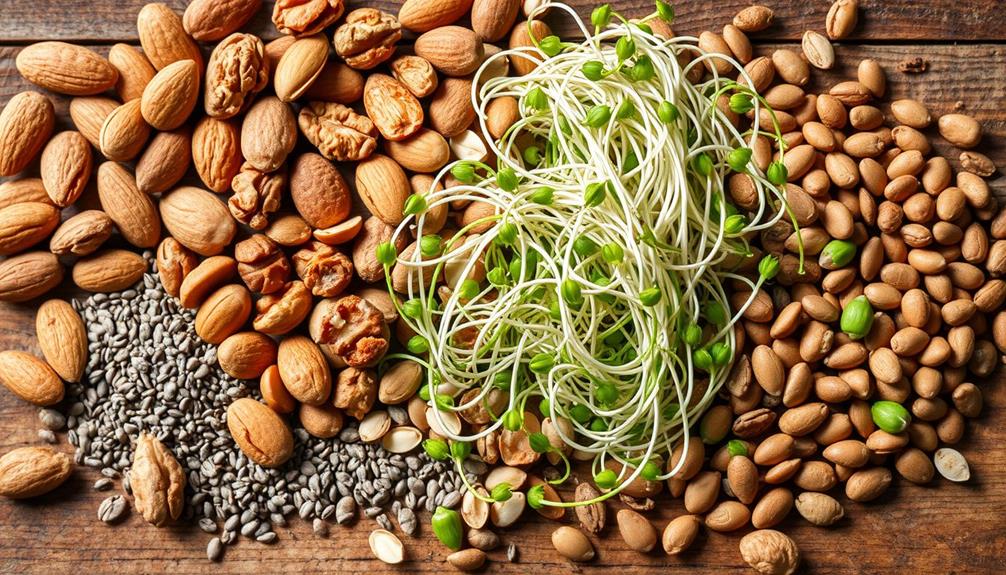
Nuts, seeds, and sprouts are powerhouse additions to your raw food diet that boost nutrition and flavor. Incorporating raw nuts like almonds, walnuts, and hazelnuts provides you with healthy fats, protein, and essential vitamins such as E and B-complex. These nutrient-dense snacks can enhance your diet healthy while satisfying your cravings.
Additionally, including safe snacks for hamsters can inspire creative ways to enjoy these foods while ensuring they're beneficial for your health.
Raw seeds, including chia, flax, and sunflower seeds, are fantastic sources of omega-3 fatty acids, antioxidants, and dietary fiber. They support heart health and digestion, making them an important part of your nutritional plan. By adding a variety of raw seeds to your meals, you can easily increase your overall nutritional value.
Don't overlook sprouts, like alfalfa or mung bean sprouts! These sprouted grains pack a punch, often containing higher nutrient levels than their unsprouted counterparts. They're rich in vitamins and minerals, contributing to your overall wellness.
You can use these nuts, seeds, and sprouts in salads, smoothies, and energy bars. They add texture and nutrient density to your meals, keeping everything fully raw and delicious.
Embrace the variety of raw options available to you, and enjoy the benefits they bring to your health!
Oils, Fats, and Condiments
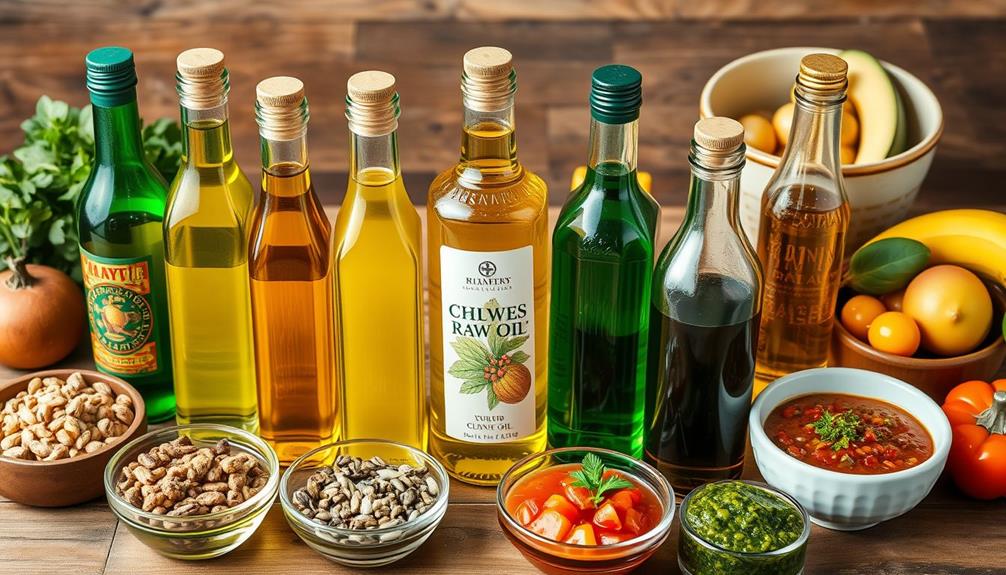
When it comes to enhancing the flavors and nutrition of your meals, incorporating quality oils, fats, and condiments is essential.
You'll want to focus on items that not only taste great but also contribute to your overall health. For instance, certain essential oils, such as eucalyptus oil, can provide additional health benefits when used in culinary applications.
Here are four key ingredients to take into account:
- Cold-pressed oils: Olive oil, avocado oil, and hemp oil are all excellent choices. They retain nutrients and provide health benefits that fit perfectly into a raw food diet.
- Raw nut butters: Almond or cashew butter delivers healthy fats and protein while being minimally processed. They add creaminess to smoothies or desserts.
- Coconut oil: Renowned for its medium-chain triglycerides (MCTs), coconut oil is versatile and can be used in various raw recipes, offering a unique flavor.
- Natural condiments: Enhance your dishes with tamari (gluten-free soy sauce) and nutritional yeast. These options boost flavor without compromising raw status.
Additionally, don't forget to include fresh herbs and spices like basil, cilantro, and turmeric.
They not only elevate the taste but also improve the nutritional profile of your raw meals with their antioxidant properties.
Unique and Superfoods
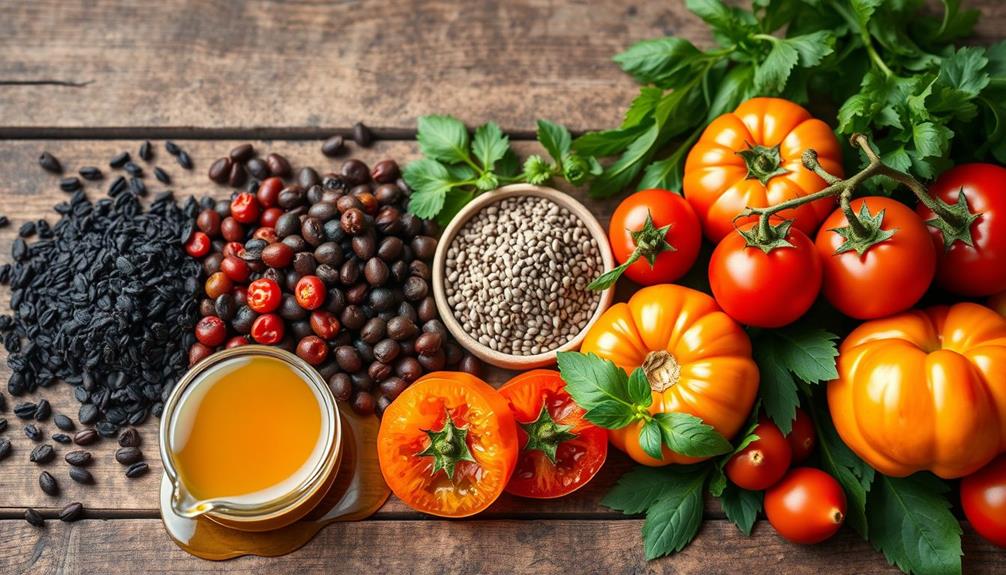
Exploring unique and superfoods can greatly elevate your raw food journey, introducing a variety of flavors and nutrients that might surprise you. Unique foods like edible weeds, such as dandelion, are often found for free outdoors and pack a punch with vitamins A, C, and K.
Seaweeds like nori and dulse aren't just tasty additions to salads and wraps; they're also rich in important minerals like iodine, which can greatly boost your immune system function boosts immune system function.
Don't overlook superfoods like spirulina and chlorella, which are notorious for their high protein content and abundance of vitamins and antioxidants. These algaes usually come in powder form, making them easy to mix into smoothies or raw dishes.
Incorporating edible flowers, like zucchini blossoms and lavender, can add unique flavors and aesthetic appeal to your meals while providing nutritional benefits.
Additionally, nutrient-dense superfoods like maca and barley grass powder can enhance your raw diet, boosting your meals with essential vitamins, minerals, and antioxidants.
Frequently Asked Questions
What Are the Raw Food Items?
When you explore raw food items, think fresh fruits, vibrant vegetables, nuts, seeds, and sprouted grains. Incorporating these nutrient-rich foods into your diet can boost your health and energy levels considerably. Enjoy the variety!
What Are Whole Raw Foods?
You might think whole raw foods are too restrictive, but they're vibrant and nutritious! Whole raw foods include fruits, vegetables, nuts, and seeds, offering essential vitamins and minerals while promoting health and well-being in your diet.
What Counts as Raw Food?
Raw food counts as unprocessed, uncooked items like fruits, vegetables, nuts, and seeds. You'll find that these foods retain their nutrients and enzymes, making them essential for a healthy, vibrant lifestyle. Avoid anything cooked or processed.
What Raw Foods Keep You Full?
If you want to feel full, incorporate high-fiber fruits like avocados, raw nuts, leafy greens, and sprouted grains. Smoothies with fruits and nut butters also help keep hunger at bay while providing essential nutrients.
Conclusion
Incorporating raw food items into your diet can be a game changer for your health. It's fascinating how a simple shift, like adding fresh fruits or nuts, can boost your energy and mood. You might just find that a crunchy carrot or a handful of sprouts becomes your new go-to snack. Coincidentally, as you explore these vibrant foods, you'll not only nourish your body but also discover a world of flavors that invigorate your meals. Enjoy the journey!

